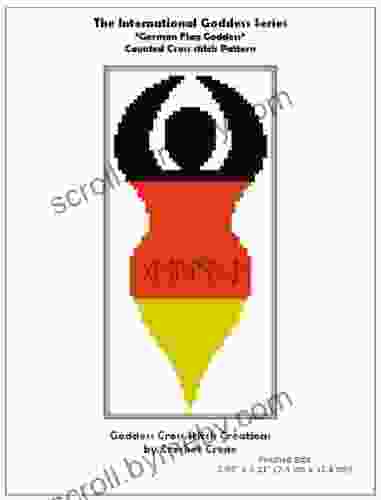Unveiling the Secrets of Visual Communication: Principles for Creating Graphics That People Understand

In a world saturated with visual stimuli, the ability to communicate effectively through graphics has become more critical than ever before. From captivating infographics to alluring advertisements, the power of visual communication lies in its ability to convey complex messages in a clear, concise, and unforgettable manner.
Understanding the principles that guide effective visual communication is paramount for anyone seeking to create graphics that resonate with their audience. These principles form the foundation upon which successful visuals are built, enabling designers and communicators to harness the power of visual language to engage, inform, and persuade.
4.6 out of 5
| Language | : | English |
| File size | : | 99056 KB |
| Text-to-Speech | : | Enabled |
| Enhanced typesetting | : | Enabled |
| Print length | : | 240 pages |
| Screen Reader | : | Supported |
Clarity: The Cornerstone of Effective Visual Communication
Clarity is the cornerstone of effective visual communication. It ensures that your message is conveyed without ambiguity or confusion, allowing your audience to grasp the intended meaning quickly and effortlessly. To achieve clarity, consider the following principles:
- Simplify your message: Avoid cluttering your graphics with excessive information or unnecessary details. Focus on conveying the core message in a concise and straightforward manner.
- Use visual hierarchy: Arrange the elements of your graphic in a logical and structured manner, guiding the viewer's eye through the key points in a sequential Free Download.
- Choose legible fonts: Select fonts that are easy to read, even from a distance or on smaller screens. Avoid using overly decorative or stylized fonts that can hinder comprehension.
- Maintain consistency: Ensure that the visual style and elements throughout your graphic are consistent, creating a cohesive and unified experience for the viewer.
Conciseness: The Art of Visual Brevity
In the fast-paced world of visual communication, conciseness is key. People are more likely to engage with graphics that are visually concise and to the point. Embrace the following principles to create visually concise graphics:
- Eliminate clutter: Remove any unnecessary elements that do not contribute to the core message. A clean and uncluttered design will enhance the impact of your graphic.
- Use negative space effectively: Negative space, or the empty space around your design elements, can play a crucial role in enhancing clarity and readability. Use it strategically to create visual balance and draw attention to important elements.
- Focus on impact: Prioritize the elements that are essential to conveying your message and give them prominence in your design. This will help create a memorable and impactful visual.
Relevance: Tailoring Graphics to Your Audience
Relevance is essential for creating graphics that resonate with your target audience. Consider their interests, knowledge level, and cultural background to tailor your visuals accordingly. By following these principles, you can ensure that your graphics are relevant and impactful:
- Know your audience: Understanding the demographics, interests, and values of your target audience is crucial for creating graphics that will connect with them.
- Use familiar imagery: Incorporate visuals that are familiar to your audience, making it easier for them to relate to the message you are conveying.
- Consider cultural context: Be mindful of cultural differences when designing graphics, as certain colors, symbols, or images may have different meanings in different cultures.
Visual Appeal: The Power of Aesthetics
While clarity, conciseness, and relevance are essential, the visual appeal of your graphics also plays a significant role. Aesthetics can enhance the impact of your message by capturing attention, creating emotional connections, and making your graphics more memorable. Consider the following principles to create visually appealing graphics:
- Use visually appealing colors: Color can evoke powerful emotions and create visual interest. Choose colors that complement your message and resonate with your audience.
- Incorporate high-quality imagery: Images can convey a wealth of information quickly and effectively. Use high-quality, relevant images that support your message and engage your audience.
- Add visual variety: Use a variety of visual elements, such as shapes, textures, and gradients, to create visual interest and keep your audience engaged.
: The Transformative Power of Effective Visual Communication
By embracing the principles of clarity, conciseness, relevance, and visual appeal, you can create graphics that not only communicate your message effectively but also engage, inform, and persuade your audience. These principles empower you to harness the transformative power of visual communication, enabling you to connect with people on a deeper level and achieve your communication goals.
Unlock the full potential of visual communication today and watch your graphics soar to new heights of clarity, impact, and memorability.
4.6 out of 5
| Language | : | English |
| File size | : | 99056 KB |
| Text-to-Speech | : | Enabled |
| Enhanced typesetting | : | Enabled |
| Print length | : | 240 pages |
| Screen Reader | : | Supported |
Do you want to contribute by writing guest posts on this blog?
Please contact us and send us a resume of previous articles that you have written.
 Book
Book Novel
Novel Page
Page Chapter
Chapter Text
Text Story
Story Genre
Genre Reader
Reader Library
Library Paperback
Paperback E-book
E-book Magazine
Magazine Newspaper
Newspaper Paragraph
Paragraph Sentence
Sentence Bookmark
Bookmark Shelf
Shelf Glossary
Glossary Bibliography
Bibliography Foreword
Foreword Preface
Preface Synopsis
Synopsis Annotation
Annotation Footnote
Footnote Manuscript
Manuscript Scroll
Scroll Codex
Codex Tome
Tome Bestseller
Bestseller Classics
Classics Library card
Library card Narrative
Narrative Biography
Biography Autobiography
Autobiography Memoir
Memoir Reference
Reference Encyclopedia
Encyclopedia O S Hawkins
O S Hawkins Cullen Roche
Cullen Roche Constantine A Balanis
Constantine A Balanis Katharine Kenah
Katharine Kenah Devon Price
Devon Price Dale Scott
Dale Scott Nina Disesa
Nina Disesa Clyde D Souza
Clyde D Souza David Cowan
David Cowan Mathivanan Palraj
Mathivanan Palraj Daisy Luther
Daisy Luther Italo Svevo
Italo Svevo Cynthia Royce
Cynthia Royce Craig A Falconer
Craig A Falconer Terry Gilliam
Terry Gilliam Michael Lakin
Michael Lakin Maria Borelius
Maria Borelius Constance Valis Hill
Constance Valis Hill D Dauphinee
D Dauphinee Jim Al Khalili
Jim Al Khalili
Light bulbAdvertise smarter! Our strategic ad space ensures maximum exposure. Reserve your spot today!

 Jeffrey HayesThe Rise and Fall of Rome's Savior: An Epic Journey of Triumph, Betrayal, and...
Jeffrey HayesThe Rise and Fall of Rome's Savior: An Epic Journey of Triumph, Betrayal, and... Franklin BellFollow ·8.1k
Franklin BellFollow ·8.1k Neal WardFollow ·3.6k
Neal WardFollow ·3.6k Scott ParkerFollow ·13.4k
Scott ParkerFollow ·13.4k VoltaireFollow ·16.5k
VoltaireFollow ·16.5k Louis HayesFollow ·15.4k
Louis HayesFollow ·15.4k Dave SimmonsFollow ·17.8k
Dave SimmonsFollow ·17.8k Frank MitchellFollow ·8.1k
Frank MitchellFollow ·8.1k Desmond FosterFollow ·7.4k
Desmond FosterFollow ·7.4k

 Cruz Simmons
Cruz SimmonsUnveiling the Secrets: An Insider Guide to School Bonds...
Unlock the Power of School...

 Gil Turner
Gil TurnerRuins of Empire: Blood on the Stars - The Epic Space...
Ruins of Empire: Blood on the Stars is the...

 Allen Ginsberg
Allen GinsbergPrepare for the Ultimate Space Opera: Delve into The Last...
Embark on an...

 Anton Foster
Anton FosterUnleash Your Inner Artist: The Ultimate Guide to Oil...
Chapter 1: The...
4.6 out of 5
| Language | : | English |
| File size | : | 99056 KB |
| Text-to-Speech | : | Enabled |
| Enhanced typesetting | : | Enabled |
| Print length | : | 240 pages |
| Screen Reader | : | Supported |














